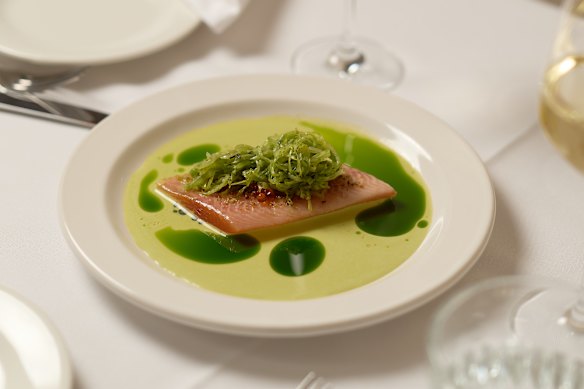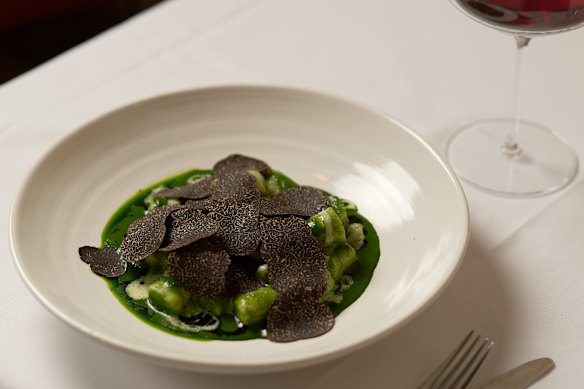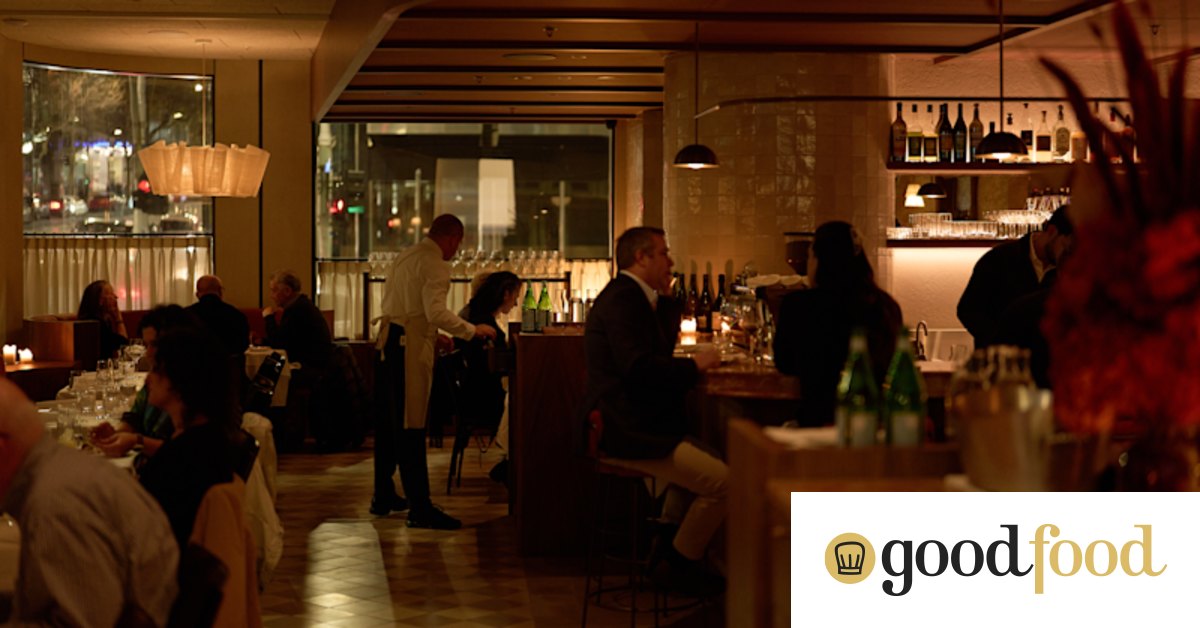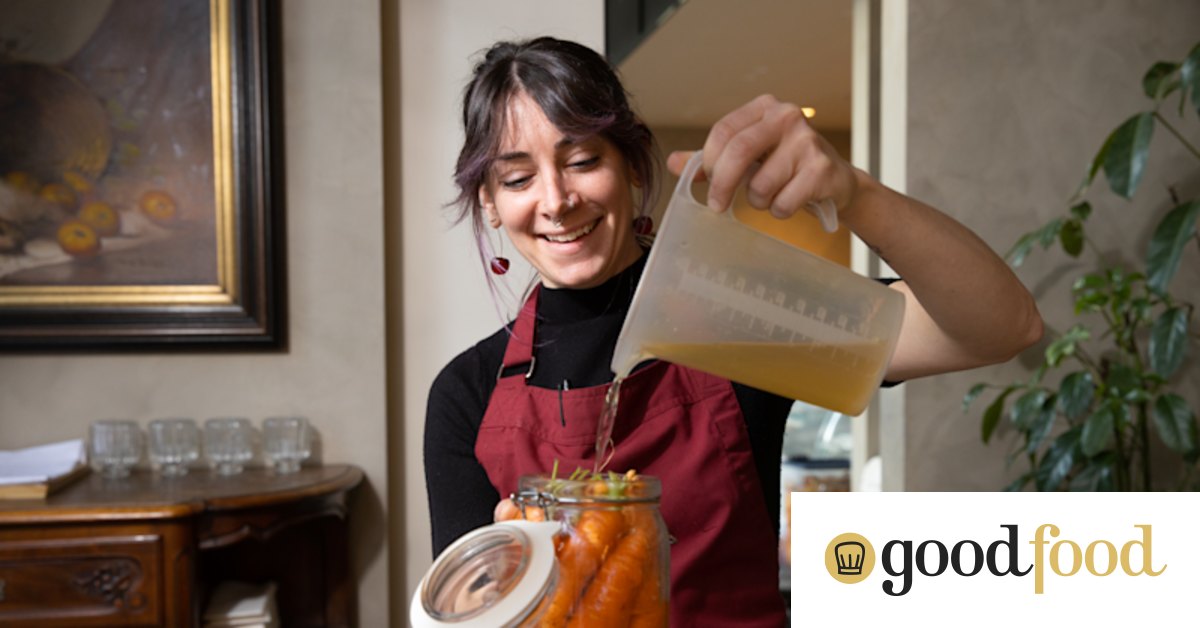The luxe Euro bistro, the latest restaurant from the team behind Tipo 00, is difficult to define.
You have reached your maximum number of saved items.
Remove items from your saved list to add more.
Save this article for later
Add articles to your saved list and come back to them anytime.
European$$$$
Is there a more Melbourne restaurant than Tipo 00? Others certainly are deserving of the title, but as an example of what we do best, it’s hard to argue that Andreas Papadakis’ 11-year old flagship isn’t a contender for the prize. Its vintage shopfront location on Little Bourke Street is unmistakably Melbourne. Its menu of gorgeous pastas and small plates eloquently reference our city’s Italian heritage. Even the style of service – friendly, efficient, no-nonsense – has a distinctly Melbourne vibe.
The same cannot be said for Harriot, the newest restaurant from Conferre Group, which owns Tipo along with Osteria Ilaria, Figlia and Grana – all restaurants with a strongly Italian identity.
Take Harriot’s setting – a new fit-out in the bottom of 555 Collins Street, the 35-storey office tower on the corner of King Street. Step through the door into the orangey-beige room, and the lo-fi luxe of the space is soothing but placeless. (It shows its sexier side at night when the room gets its glow on.)
The food is a little bit French, a little bit British, a Euro-ish theme that is decidedly not faithful to one region. This makes sense when looking at the background of head chef James Kelly, who cooked at Embla then spent time at London’s highly respected Lyle’s before landing back in Melbourne. This is his first gig as head chef, but it plays as the work of someone decidedly assured in his cooking.
In a town with so much raw fish in tiny bites, the jewel-like bluefin tuna tart manages to stand out here, the deep and sweet fish bolstered (and not overwhelmed) by fermented porcini.
The dense meatiness of a classic pig’s head terrine is given lift and contrast by its accompaniments of witlof leaves and a lovely sweet-tart quince puree.

A rainbow trout entree is a showcase for what I assume Kelly is aiming to achieve here: it sings of quiet luxury and subtle saucing, and is somewhat of a throwback to the French cooking of the 1970s, the poached pink fish in a delicate sorrel sauce, no element screaming for attention but everything working in harmony.
Sauce is, in many ways, the star of this menu. There’s currently a gnocchi on offer that sits in a brilliant emerald kale emulsion. I wasn’t planning on ordering it until the waft of black truffles found me from another table – when the dish arrived it was covered in a blanket of truffle.
Often, raw sliced truffle is a waste: too blunt, too cold. (My late stepfather, a journalist and also a part-time truffle salesman, used to complain endlessly about restaurants “bunging” truffle on top of dishes rather than cooking with it.) But here the gnocchi and sauce warm the truffle enough to release its perfume, imbuing the whole dish with its foresty wonder.

Some main courses are stock-standard luxe fare: a perfectly cooked duck breast with orange and shallot; a wagyu rump that has its already lush flesh ramped up to a zillion on the richness scale with the addition of a sauce made from bone marrow.
The star dish, though, is undoubtedly lamb sweetbreads. The preparation changes – I had a classic caper-lemon-brown butter situation – but the beautiful creamy-in-the-centre, crisp on the outside saute they’re given does not.
My worry for Harriot is that its aim is quite broad, in a town that can have a short attention span for restaurants that don’t fit into a neat box.
The loose Euro theme also allows for sommelier Justin Howe to delve deeply into French nerdery, and the list he’s put together is reason enough to visit Harriot. Broken down by Old and New World, it includes one of the better collections of Burgundies in town, with fun asides into Australia, Germany, and yes, Italy.
Howe’s wine talk is personal and to the point. He isn’t trying to upsell you, and he’s a master at finding bottles within the confines of budget, taste and the food you’re eating.
I suppose my worry for Harriot is that its aim is quite broad in a town that can have a short attention span for restaurants that don’t fit into a neat box. It’s not a wine bar (not casual enough), nor is it classic fine dining. It’s not easily definable, nor is it cutting edge. However, it is a showcase of Kelly’s cooking skills, and the sweetbreads alone will have me coming back, as will that wine list.
While Harriot may be a departure for this group, I’m heartened to see one of the city’s great operators betting on the talent of their younger staff. The hope is that Harriot is pretty enough, friendly enough and delicious enough that its inherent quality will see it through. What’s more Melbourne than that?
The low-down
Atmosphere: Modern lo-fi luxe
Go-to dishes: Tuna tart ($14); Gnocchi with kale and comte ($46); Lamb sweetbreads ($29)
Drinks: Sharp spins on classic cocktails, extensive wine list with a focus on France
Cost: About $175 for two, excluding drinks
Good Food reviews are booked anonymously and paid independently. A restaurant can’t pay for a review or inclusion in the Good Food Guide.
Restaurant reviews, news and the hottest openings served to your inbox.
You have reached your maximum number of saved items.
Remove items from your saved list to add more.






